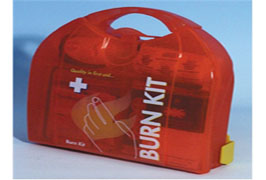Burn Injuries
Burns can be caused by fire, the sun, chemicals, heated objects or fluids, and electricity. They can be minor problems or life-threatening emergencies. Distinguishing a minor burn from a more serious burn involves determining the degree of damage to the tissues of the body. If you are not sure how serious the burn is seek emergency medical help.
Signs/Symptoms:
To distinguish a minor burn from a serious burn, the first step is to determine the degree and the extent of damage to body tissues. The three classifications of first-degree burn, second-degree burn and third-degree burn will help you determine the emergency care needed:
First-Degree Burn
These are the least serious type of burns and are those in which only the outer layer of skin is burned. The skin is usually red, with swelling and pain sometimes present. The outer layer of skin hasn’t been burned through. Treat a first-degree burn as a minor burn unless it involves substantial portions of the hands, feet, face, groin or buttocks, or a major joint.
Second-Degree Burn
Third-Degree Burn
The most serious burns are painless, involve all layers of the skin and cause permanent tissue damage. Fat, muscle and even bone may be affected. Areas may be charred black or appear dry and white. Difficulty inhaling and exhaling, carbon monoxide poisoning, or other toxic effects may occur if smoke inhalation accompanies the burn.
Treatment For Minor Burns
- Cool the burn. Hold the burned area under cold running water for at least five minutes, or until the pain subsides. If this is impractical (for instance if the burn is on a foot) immerse the burn in cold water or cool it with cold compresses. Cooling the burn reduces swelling by conducting heat away from the skin. Never apply ice or cold compresses directly to the skin.
- Cover the burn with a sterile gauze bandage. Don’t use fluffy cotton, which may irritate the skin. Wrap the gauze loosely to avoid putting pressure on burned skin. Bandaging keeps air off the burned skin, reduces pain, prevents entry of micro-organisms and protects blistered skin.
- Take an over-the-counter pain reliever. These include aspirin, ibuprofen (Advil, Motrin, others), naproxen (Aleve) or acetaminophen (Tylenol, others). Never give aspirin to children or teenagers.
Treatment For A Major Burn
- Do or Don’t remove burnt clothing. However, do make sure the victim is no longer in contact with smouldering materials or exposed to smoke or heat.
- Don’t immerse large severe burns in cold water. Doing so could cause shock.
- Check for signs of circulation (pulse, breathing, coughing or movement). If the person is not breathing begin mouth to mouth resuscitation. If there is no pulse or other sign of circulation, begin CPR.
- Elevate the burned body part or parts. Raise the afflicted area above heart level, when possible.
- Cover the area of the burn. Use a cool, moist, sterile bandage; clean, moist cloth; or moist towels.
Prevention Of Burns:
- To reduce and remove the risk of burns and scalds for children:-
- Guard open fires and heaters with spark guards and fire guards
- Keep hot drinks out of the reach of children, never hold a hot drink when playing with your child or around playing children
- Avoid using table cloths as children tend to grasp and pull them
- Never smoke around your child, it not only presents a potential burn risk but also a serious health and fire risk.
- Switch off and turn off electrical appliances when not in use.
- Always keep matches and lighters out of reach of children.
- Use a cooker guard for protection and always cook on the back rings where possible. Turn handles in and away from childrens reach and view.
- Make sure candles are secure in a proper holder and out of the reach of children.
- Never leave lit candles unattended and avoid moving lit candles around.








